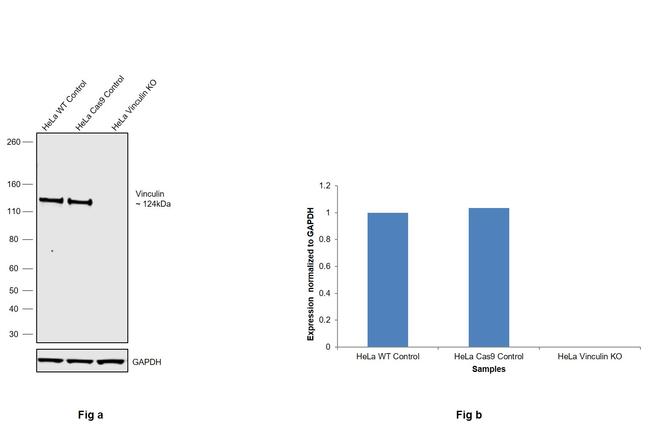Search Thermo Fisher Scientific
Invitrogen
Vinculin Monoclonal Antibody (7F9), eBioscience™
This Antibody was verified by Knockout to ensure that the antibody binds to the antigen stated.
FIGURE: 1 / 9
Vinculin Antibody (14-9777-82) in WB


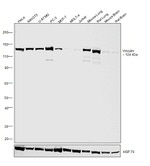
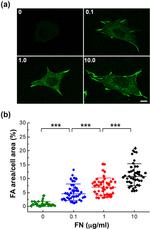
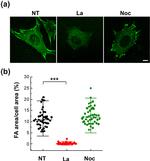
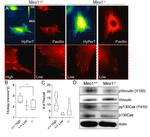
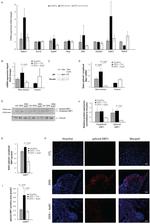
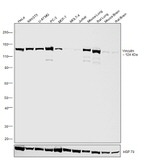

Product Details
14-9777-82
Species Reactivity
Published species
Host/Isotype
Class
Type
Clone
Conjugate
Form
Concentration
Purification
Storage buffer
Contains
Storage conditions
Shipping conditions
RRID
Product Specific Information
Description: The monoclonal antibody 7F9 (VIIF9) recognizes human, mouse, rat, and avian vinculin and its alternatively spliced isoform, metavinculin. Vinculin is a cytoskeletal protein associated with cell-cell and cell-matrix junctions. Vinculin is involved in the anchoring of F-actin to the membrane and the regulation of E-cadherin expression. Vinculin binds to talin, paxillin, and alpha-actinin. Disregulation of vinculin alters cell adhesion, migration, and growth, which promotes cancer invasion and metastasis.
Applications Reported: This 7F9 antibody has been reported for use in western blotting, immunohistochemical staining of frozen tissue sections and formalin-fixed paraffin embedded tissue sections, immunocytochemistry, and microscopy.
Applications Tested: This 7F9 antibody has been tested by immunocytochemistry on methanol-fixed or formaldehyde-fixed and permeabilized cells and can be used at less than or equal to 5 µg/mL. This antibody has been tested by immunohistochemistry of formalin-fixed paraffin embedded tissue using low pH antigen retrieval buffer and can be used at less than or equal to 5 µg/mL. The antibody has been tested by western blot on reduced and non-reduced cell lysates and can be used at less than or equal to 5 µg/mL. It is recommended that the antibody be carefully titrated for optimal performance in the assay of interest.
Purity: Greater than 90%, as determined by SDS-PAGE.
Aggregation: Less than 10%, as determined by HPLC.
Filtration: 0.2 µm post-manufacturing filtered.
Target Information
Vinculin (VCL) is a cytoskeletal protein associated with cell-cell and cell-extracellular matrix adherens-type junctions. It functions as one of several interacting proteins involved in anchoring F-actin to the membrane. It has been shown that a sequence of molecular interactions might be involved in the transmembrane assembly of adhesion plaques. In the assembly of adhesion plaques, the beta subunit of integrin binds to talin. Talin binds to vinculin that interacts with alpha-actinin and possibly with itself. Since alpha-actinin binds to and cross-links actin filaments, vinculin represents a key element in the transmembrane linkage of the extracellular matrix to the cytoplasmic microfilament system. Mutations in the gene can result in cardiomyopathy dilated 1W or familial hypertrophic 15.
For Research Use Only. Not for use in diagnostic procedures. Not for resale without express authorization.
Bioinformatics
Protein Aliases: epididymis luminal protein 114; Metavinculin; metavinculin {ECO:0000250|UniProtKB:P18206}; MV; RP11-178G16.3; vcl {ECO:0000250|UniProtKB:P18206}; vinc; Vinculin; vinculin {ECO:0000250|UniProtKB:P18206}
Gene Aliases: 9430097D22; AA571387; AI462105; AW545629; CMD1W; CMH15; HEL114; MV; MVCL; VCL
UniProt ID: (Human) P18206, (Mouse) Q64727, (Rat) P85972
Entrez Gene ID: (Human) 7414, (Mouse) 22330, (Rat) 305679

Performance Guarantee
If an Invitrogen™ antibody doesn't perform as described on our website or datasheet,we'll replace the product at no cost to you, or provide you with a credit for a future purchase.*
Learn more
We're here to help
Get expert recommendations for common problems or connect directly with an on staff expert for technical assistance related to applications, equipment and general product use.
Contact tech support
